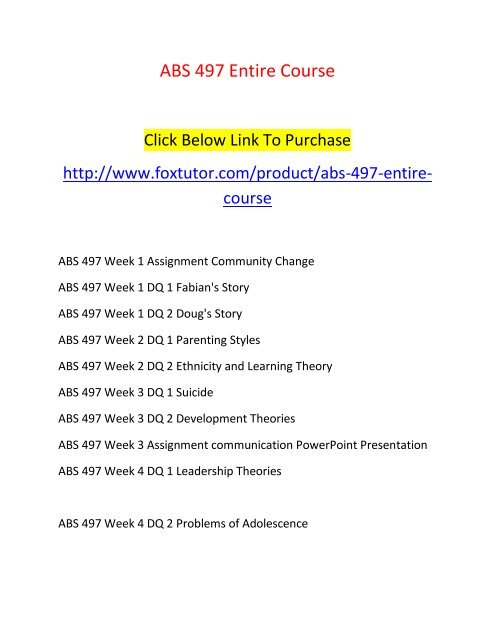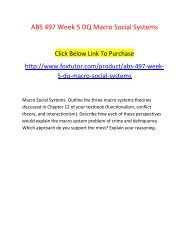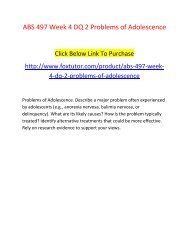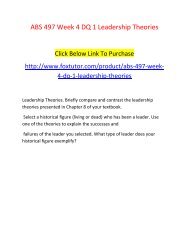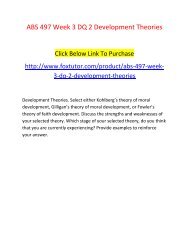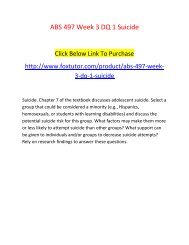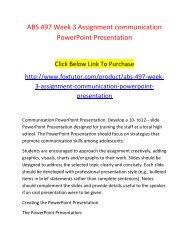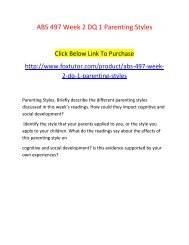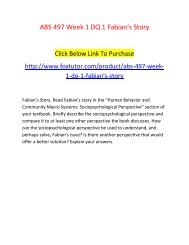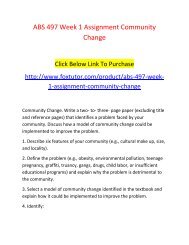ABS 497 All Assignments
Create successful ePaper yourself
Turn your PDF publications into a flip-book with our unique Google optimized e-Paper software.
<strong>ABS</strong> <strong>497</strong> Entire Course<br />
Click Below Link To Purchase<br />
http://www.foxtutor.com/product/abs-<strong>497</strong>-entirecourse<br />
<strong>ABS</strong> <strong>497</strong> Week 1 Assignment Community Change<br />
<strong>ABS</strong> <strong>497</strong> Week 1 DQ 1 Fabian's Story<br />
<strong>ABS</strong> <strong>497</strong> Week 1 DQ 2 Doug's Story<br />
<strong>ABS</strong> <strong>497</strong> Week 2 DQ 1 Parenting Styles<br />
<strong>ABS</strong> <strong>497</strong> Week 2 DQ 2 Ethnicity and Learning Theory<br />
<strong>ABS</strong> <strong>497</strong> Week 3 DQ 1 Suicide<br />
<strong>ABS</strong> <strong>497</strong> Week 3 DQ 2 Development Theories<br />
<strong>ABS</strong> <strong>497</strong> Week 3 Assignment communication PowerPoint Presentation<br />
<strong>ABS</strong> <strong>497</strong> Week 4 DQ 1 Leadership Theories<br />
<strong>ABS</strong> <strong>497</strong> Week 4 DQ 2 Problems of Adolescence
<strong>ABS</strong> <strong>497</strong> Week 5 DQ Macro Social Systems<br />
<strong>ABS</strong> <strong>497</strong> Week 5 Final Paper<br />
<strong>ABS</strong> <strong>497</strong> Week 1 Assignment Community<br />
Change<br />
Click Below Link To Purchase<br />
http://www.foxtutor.com/product/abs-<strong>497</strong>-week-<br />
1-assignment-community-change<br />
Community Change. Write a two- to- three- page paper (excluding title<br />
and reference pages) that identifies a problem faced by your<br />
community. Discuss how a model of community change could be<br />
implemented to improve the problem.<br />
1. Describe six features of your community (e.g., cultural make up, size,<br />
and locality).
2. Define the problem (e.g., obesity, environmental pollution, teenage<br />
pregnancy, graffiti, truancy, gangs, drugs, child labor, or insufficient<br />
educational programs) and explain why the problem is detrimental to<br />
the community.<br />
3. Select a model of community change identified in the textbook and<br />
explain how it could be implemented to improve the problem.<br />
4. Identify:<br />
a. At least three aspects of the problem you think that the model will be<br />
most successful at solving and provide reasoning as to why.<br />
b. At least three aspects of the problem you think that the model will<br />
struggle to solve and provide reasoning as to why.<br />
The bulk of your paper should focus on the third component above (the<br />
model of community change). Your paper must include a minimum of<br />
two scholarly sources and be formatted according to APA style as<br />
outlined in the Ashford Writing Center.<br />
<strong>ABS</strong> <strong>497</strong> Week 1 DQ 1 Fabian's Story<br />
Click Below Link To Purchase
http://www.foxtutor.com/product/abs-<strong>497</strong>-week-<br />
1-dq-1-fabian's-story<br />
Fabian’s Story. Read Fabian’s story in the “Human Behavior and<br />
Community Macro Systems: Sociopsychological Perspective” section of<br />
your textbook. Briefly describe the sociopsychological perspective and<br />
compare it to at least one other perspective the book discusses. How<br />
can the sociopsychological perspective be used to understand, and<br />
perhaps solve, Fabian’s issue? Is there another perspective that would<br />
offer a better solution? Explain your answers.<br />
<strong>ABS</strong> <strong>497</strong> Week 1 DQ 2 Doug's Story<br />
Click Below Link To Purchase<br />
http://www.foxtutor.com/product/abs-<strong>497</strong>-week-<br />
1-dq-2-doug's-story
Doug’s Story. Read Doug’s story in the Human Ecology Perspective<br />
section of your textbook. Respond to the ethical questions that follow.<br />
To what extent is economic inequality fair? Did Doug have the right to<br />
vent his anger in such a violent manner? What, if anything, could be<br />
done to improve Doug’s economic and ecological status?<br />
<strong>ABS</strong> <strong>497</strong> Week 2 DQ 1 Parenting Styles<br />
Click Below Link To Purchase<br />
http://www.foxtutor.com/product/abs-<strong>497</strong>-week-<br />
2-dq-1-parenting-styles<br />
Parenting Styles. Briefly describe the different parenting styles<br />
discussed in this week’s readings. How could they impact cognitive and<br />
social development?<br />
Identify the style that your parents applied to you, or the style you<br />
apply to your children. What do the readings say about the effects of<br />
this parenting style on
cognitive and social development? Is this evidence supported by your<br />
own experiences?<br />
<strong>ABS</strong> <strong>497</strong> Week 2 DQ 2 Ethnicity and Learning<br />
Theory<br />
Click Below Link To Purchase<br />
http://www.foxtutor.com/product/abs-<strong>497</strong>-week-<br />
2-dq-2-ethnicity-and-learning-theory<br />
Ethnicity and Learning Theory. Select an ethnic group from your<br />
textbook, or outside readings, and discuss how the application of<br />
learning theory may vary according to the cultural beliefs and values of<br />
this group. Based on the research, justify why you think specific<br />
learning techniques could be used by your chosen ethnic group.
<strong>ABS</strong> <strong>497</strong> Week 3 Assignment communication<br />
PowerPoint Presentation<br />
Click Below Link To Purchase<br />
http://www.foxtutor.com/product/abs-<strong>497</strong>-week-<br />
3-assignment-communication-powerpointpresentation<br />
Communication PowerPoint Presentation. Develop a 10- to12-- slide<br />
PowerPoint Presentation designed for training the staff at a local high<br />
school. The PowerPoint Presentation should focus on strategies that<br />
promote communication skills among adolescents.<br />
Students are encouraged to approach the assignment creatively, adding<br />
graphics, visuals, charts and/or graphs to their work. Slides should be<br />
designed to address the selected topic clearly and concisely. Each slide<br />
should be developed with professional presentation style (e.g., bulleted<br />
items in brief statements rather than complete sentences). Notes<br />
should complement the slides and provide details useful to the speaker<br />
if an oral presentation were to be given.
Creating the PowerPoint Presentation<br />
The PowerPoint Presentation:<br />
1. Must be 10 to 12 slides, and formatted according to APA style as<br />
outlined by the Ashford Writing Center.<br />
2. Must include a title slide with the following:<br />
a. Title of the training<br />
b. Student’s name<br />
c. Course name and number<br />
d. Instructor’s name<br />
e. Date submitted<br />
3. Must present a thesis statement regarding why social skills training<br />
would be appropriate for adolescents.<br />
4. Must explain different types of communication (e.g., aggressive and<br />
assertive).<br />
5. Must share four strategies on how adolescents could improve their<br />
communication skills.<br />
6. Must create at least three hypothetical scenarios of problems that<br />
adolescents might encounter, including one that involves<br />
cultural/ethnic issues. The scenarios should show how adolescents<br />
could use improved communication skills to solve these problems.<br />
7. Must develop conclusions that reiterate the opening thesis<br />
statement, include a summary of the social skills training discussed, and<br />
offer evidence of its effectiveness.
8. Must use at least four scholarly sources (in addition to the course<br />
text), including a minimum of two from the Ashford Online Library.<br />
References are to be provided as needed within the slides.<br />
9. Must include a separate reference slide, formatted according to APA<br />
style as outlined in the Ashford Writing Center.<br />
For tips on creating an excellent presentation, read this overview.<br />
<strong>ABS</strong> <strong>497</strong> Week 3 DQ 1 Suicide<br />
Click Below Link To Purchase<br />
http://www.foxtutor.com/product/abs-<strong>497</strong>-week-<br />
3-dq-1-suicide<br />
Suicide. Chapter 7 of the textbook discusses adolescent suicide. Select a<br />
group that could be considered a minority (e.g., Hispanics,<br />
homosexuals, or students with learning disabilities) and discuss the<br />
potential suicide risk for this group. What factors may make them more<br />
or less likely to attempt suicide than other groups? What support can
e given to individuals and/or groups to decrease suicide attempts?<br />
Rely on research findings to answer these questions.<br />
<strong>ABS</strong> <strong>497</strong> Week 3 DQ 2 Development Theories<br />
Click Below Link To Purchase<br />
http://www.foxtutor.com/product/abs-<strong>497</strong>-week-<br />
3-dq-2-development-theories<br />
Development Theories. Select either Kohlberg’s theory of moral<br />
development, Gilligan’s theory of moral development, or Fowler’s<br />
theory of faith development. Discuss the strengths and weaknesses of<br />
your selected theory. Which stage of your selected theory, do you think<br />
that you are currently experiencing? Provide examples to reinforce<br />
your answer.
<strong>ABS</strong> <strong>497</strong> Week 4 DQ 1 Leadership Theories<br />
Click Below Link To Purchase<br />
http://www.foxtutor.com/product/abs-<strong>497</strong>-week-<br />
4-dq-1-leadership-theories<br />
Leadership Theories. Briefly compare and contrast the leadership<br />
theories presented in Chapter 8 of your textbook.<br />
Select a historical figure (living or dead) who has been a leader. Use<br />
one of the theories to explain the successes and<br />
failures of the leader you selected. What type of leader does your<br />
historical figure exemplify?<br />
<strong>ABS</strong> <strong>497</strong> Week 4 DQ 2 Problems of Adolescence
Click Below Link To Purchase<br />
http://www.foxtutor.com/product/abs-<strong>497</strong>-week-<br />
4-dq-2-problems-of-adolescence<br />
Problems of Adolescence. Describe a major problem often experienced<br />
by adolescents (e.g., anorexia nervosa, bulimia nervosa, or<br />
delinquency). What are its likely causes? How is the problem typically<br />
treated? Identify alternative treatments that could be more effective.<br />
Rely on research evidence to support your views.<br />
<strong>ABS</strong> <strong>497</strong> Week 5 DQ Macro Social Systems<br />
Click Below Link To Purchase<br />
http://www.foxtutor.com/product/abs-<strong>497</strong>-week-<br />
5-dq-macro-social-systems
Macro Social Systems. Outline the three macro systems theories<br />
discussed in Chapter 12 of your textbook (functionalism, conflict<br />
theory, and interactionism). Describe how each of these perspectives<br />
would explain the macro system problem of crime and delinquency.<br />
Which approach do you support the most? Explain your reasoning.<br />
<strong>ABS</strong> <strong>497</strong> Week 5 Final Paper<br />
Click Below Link To Purchase<br />
http://www.foxtutor.com/product/abs-<strong>497</strong>-week-<br />
5-final-paper<br />
Final Paper<br />
To complete the following final paper, go to this week's Final Paper link<br />
in the left navigation.<br />
Final Paper
Focus of the Final Paper<br />
Imagine that you are a researcher and are conducting a study to<br />
investigate a community problem. Using behavioral research principles,<br />
select a macro systems problem to investigate (there are many<br />
suggested in the textbook, e.g. domestic violence, homophobia, sexual<br />
abuse, delinquent gangs) and design a study to solve this community<br />
problem.<br />
The purpose of your Final Paper is to solve this community problem.<br />
The Final Paper should be eight- to- ten pages (excluding title and<br />
reference pages) that includes the following components:<br />
(Please note that for the purposes of offering instruction, examples<br />
have been given below about a research study involving the use of<br />
financial reward programs to combat truancy. Please make sure that<br />
you create a study that does not investigate the same content.)<br />
I. Introduction – This section should include a brief summary of the<br />
community problem that will be addressed, as well as the approach<br />
that will be used to investigate and solve the problem.<br />
II. Statement of the problem – The purpose of this section is to specify<br />
the main research question (e.g., Does enrollment in a financial reward<br />
program reduce truancy?) and define the community problem in more<br />
depth (e.g., truancy), analyzing why it is a problem. In addition, you will<br />
explain the problem-solving method you plan to employ (e.g.,<br />
enrollment in a financial reward program) and state your main<br />
hypothesis. (e.g., Enrollment in a financial reward program is expected<br />
to reduce student truancy in the short term, but its long-term effects<br />
are difficult to predict.)
III. Literature Review – In this section, research findings pertaining to<br />
both the community problem and problem solving method need to be<br />
illustrated. (e.g., Relevant articles may include those on the prevalence<br />
of truancy, the impact of truancy, previous methods used to combat<br />
truancy, and the benefits of financial reward programs.)<br />
IV. Methodology – Explain how your Final Paper will investigate the<br />
problem. How will the study be designed? How many participants will<br />
be involved in the study and how will they be recruited? (e.g., Four<br />
classes at a local high school will be given the opportunity to participate<br />
in the research study. Two of these classes will be enrolled in the<br />
financial reward program.) How will data be collected? (e.g., Truancy<br />
data will be collected on all of the participants for the six months<br />
preceding the reward program, for the duration of the program, and for<br />
the six months after completion of the reward program.) What<br />
statistics will be used to evaluate the data? (e.g., Inferential statistics<br />
will be conducted to compare the truancy levels of the group of<br />
students participating in the program with those of the group of<br />
students who are not participating in the program.) Ethical<br />
considerations should be discussed to ensure that no unethical<br />
research is suggested.<br />
V. Conclusions – This section should contain concluding remarks about<br />
any potential problems that might be encountered in conducting this<br />
research study. It should also include speculations on the potential<br />
results of the study.<br />
Writing the Final Paper
The Final Paper:<br />
1. Must be eight to ten double-spaced pages in length, and formatted<br />
according to APA style as outlined in the Ashford Writing Center.<br />
2. Must include a title page with the following:<br />
a. Title of paper<br />
b. Student’s name<br />
c. Course name and number<br />
d. Instructor’s name<br />
e. Date submitted<br />
3. Must begin with an introductory paragraph that has a succinct thesis<br />
statement.<br />
4. Must address the topic of the paper with critical thought.<br />
5. Must end with a conclusion that reaffirms your thesis.<br />
6. Must use at least five scholarly sources, including a minimum of<br />
three from the Ashford Online Library.<br />
7. Must document all sources in APA style, as outlined in the Ashford<br />
Writing Center.<br />
8. Must include a separate reference page, formatted according to APA<br />
style as outlined in the Ashford Writing Center.


